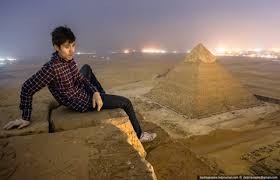Feel beauty supply, post 4
To the pyramids!

I believe I am a few days late for my fourth post, the post in which I am finally to take you to the pyramids with Kant as our guide. My apologies. I haven’t neglected this expedition in thought, though perhaps in type. In fact one might say that I have been preparing for it at a somatic level for several weeks now by visiting Florida, a place that is not exactly Egypt, though no doubt a site in which European colonialism grappled with the dynamic sublime, and New York City, where one seemingly experiences the mathematical sublime of capital on every corner.
What I want to call attention to in this post is the telling nature of examples in philosophical texts, especially in a text like Kant’s. Unlike Hegel, Marx, or other nineteenth-century philosophies dependent on narratives of socio-historical development, Kant’s critiques are on the surface ahistorical. He is describing the functions of the mind and all its faculties much like a doctor might describe the operations of a healthy human knee in an anatomy textbook. [My example here is telling, too. I’ve become obsessed once again with the Women’s World Cup, hence also with the healthy knee.] Human minds and knees function in the same way in any century, or so a critique like Kant’s allows the reader to presume.
Kant’s arguments, however, seemingly innocently or unconsciously, provide the reader with examples that betray Kant’s own historical context. Already in his discussion of the Beautiful we see the specter of the French Revolution. Kant asks the reader to consider what it would mean to judge a palace to be beautiful, then offers some ways of judging it non-aesthetically, including a Rousseauian critique: “I might even go on, as Rousseau would, to rebuke the vanity of the great who spend the people’s sweat on such superfluous things.”(§2) Given the critique’s publication date (1790) one would think it a difficult time for many Europeans to look at a palace with disinterest, to judge such a thing beautiful. To do so, for Kant, would be an act of freedom. But what is such freedom? Is it simply a means of momentarily evaporating one’s investments in a socio-political reality? An escapism?
Kant’s example in his discussion of the Sublime complicates the matter of freedom. This complexity is partially due to the nature of the Sublime itself. To judge aesthetically something to be “absolutely large” is to experience it as mathematically sublime. What this means is that the viewer in the moment of perceiving the object visually perceives that object as infinite in size. That is, due to the viewer’s physical position in relationship to the object, the object appears as if it has no beginning and no end, that it is absolutely large. This moment reveals to the viewer the frailty of the faculty of imagination by allowing the material world to overpower the human subject (in Kant’s paradigm the imagination captures and organizes visual data into schema.) When the imagination is unable to schematize the visual object, to possess it as a series of visual points that the understanding can reduce to a concept, the human subject panics. The world threatens to dominate him [it’s always a him in these texts.] Luckily, as Kant informs us, we have the faculty of Reason. Reason conceptualizes the suprasensible, those concepts that are independent of sense, like heaven, God, infinity, etc. So when our imagination and understanding can’t navigate the reality before us, Reason steps in and allows us to conceptualize the uncapturable object as an infinity. Infinity is revealed to us then as a finite concept of our Reason, so that what physically seems to dominate us is checked by the capacities of our mind. This is where the pleasure of the sublime is located. The human subject through the functioning of his faculties comes to understand that nothing in the physical world can overwhelm his Reason. The Sublime reveals that humanity is not dependent on sensory experience and the material world. Mind can conquer all.
Kant’s example goes on to insinuate something more than Reason’s simple independence from physical threat. In §26 Kant writes: “[The Sublime] serves to explain a comment made by Savary in his report on Egypt: that in order to get the full emotional effect from the magnitude of the pyramids one must neither get too close to them nor stay to far away.” Here Kant is attempting to communicate to the reader the need to position himself just so in front of an object in order to perceive it as a visual infinity, but who is Savary? According to the footnote in Werner Pluhar’s translation Savary was “Duke of Rovigo, (1774-1833), French general, diplomat, and later minister of police (notorious for his severity) under Napoleon Bonaparte, but active even after the latter’s banishment to St. Helena in 1815. Savary took part in Bonaparte’s expedition to Egypt.” (108) So the example of the Sublime here is a French colonial action.
This is then quite a different “purpose” for the Sublime. In his attempt to posit Reason as a human universal that “frees” all humans from physical constraints, Kant offers us an example of European military domination. Though not explicit, the example suggests the aesthetic to be a means of colonial capture. The pyramids in their size and history suggest a world order much greater and older than Europe’s, yet the Sublime allows the French general to feel a freedom in himself as he stands before them. He is free enough to feel himself superior in the name of France. His cognitive capacity operates as a tool in the service of a national regime.
But now in a great act of hypocrisy, readers, I must go watch the French women dominate England in football.
FEEL BEAUTY SUPPLY